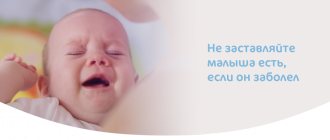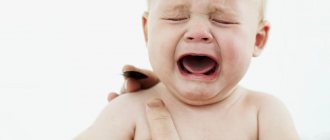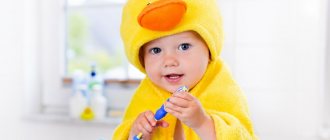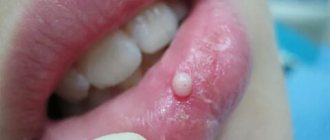When do babies' first teeth start to come out?
The table shows at what age children’s first teeth erupt and in what order ( to understand the table, please look at the photo below ):
| Baby's age | Place of cutting |
| 6-7 months | Lower central incisors |
| 8-9 months | Upper central incisors |
| 9-11 months | Upper lateral incisors |
| 11-13 months | Lower lateral incisors |
| 12-15 months | Upper small molars (molars) |
| 12-15 months | Lower small molars (molars) |
| 16-18 months | Upper canines |
| 18-20 months | Lower canines |
| 24-30 months | Lower large molars (molars) |
| 24-30 months | Upper large molars (molars) |
As doctors note, babies’ first teeth begin to emerge at 6-9 months. If the time frame is somewhat delayed, parents should take the child to a pediatrician and dentist. If we talk about the fact that the timing of the appearance of teeth may be atypical, this may indicate certain disorders in the baby’s body:
- if teeth come in 2 months later than normal, this may indicate an infectious disease in the body, a malfunction in metabolic processes and the functioning of the digestive tract;
- when teeth come in 2 months ahead of schedule - this may indicate a malfunction of the endocrine system;
- If the first teeth in infants are cut incorrectly, outside the gum, this indicates an incorrect position of the tooth axis. In this case, surgeons will have to intervene, using special bales and prostheses to guide it correctly.
If there are certain suspicions of pathology or its detection, it is best to show the child to a pediatrician and pediatric dentist.
Causes of delayed eruption of permanent teeth –
If for baby teeth delayed eruption is considered to be a delay of only 2-3 months, then for permanent teeth this figure is already 2-4 years. Among the main reasons for the delay in the eruption of permanent teeth, it is particularly worth highlighting the preceding inflammatory processes in the area of the roots of primary teeth, as well as the early removal of primary molars.
1) Violation of local conditions for teething:
- underdevelopment of the upper and lower jaws,
- lack of space in the dentition,
- premature removal of primary molars,
- incorrect position of the tooth germ,
- tooth germ injury,
- inflammation in the bone tissue of the jaws, for example, with purulent periodontitis of baby teeth.
2) Common causes of delayed eruption of permanent teeth:
- rickets or congenital syphilis,
- exudative diathesis,
- various chronic intoxications,
- metabolic disorders,
- disturbances of reflex-trophic processes,
- hormonal imbalances (for example, hypothyroidism, hypofunction of the thymus or adrenal glands).
Which permanent teeth are more likely to experience delayed eruption?
- one of the canines of the upper jaw (MF) – occurs in 43.64% of children,
- two HF fangs at once – in 25.65%,
- second premolar of the mandible (MF) – in 12.84%,
- two HF canines and LF second premolars at once – in 10.34%,
- both second premolars LF – in 5.11%,
- both lateral incisors HF – in 2.61%.
What factors can affect tooth growth in children?
Boys and girls begin to cut their teeth at different times, but in any case, it is worth taking into account the factors that influence this timing.
- Hereditary predisposition and the baby’s diet - if there is a lack of calcium in the body, supplemented by a genetic program, the baby’s teeth will begin to grow late.
- Climate and region of residence - boys and girls living in hot regions begin teething earlier than children who live in a temperate climate zone.
- Boys and girls cut their teeth at different times - in particular, in the latter they begin to emerge earlier, starting to break through at 6-9 months.
However, the question of when a baby’s teeth begin to grow should be considered from an individual perspective - if they began to grow later or earlier, then this should not immediately be considered a deviation from the norm.
Period of eruption of permanent teeth -
The eruption of permanent teeth has a number of features, because... This process occurs simultaneously with the resorption of roots and loss of baby teeth. The rudiments of permanent teeth are located only 1-2 mm from the roots of milk teeth, and when a permanent tooth begins to erupt, it puts pressure on the roots of the milk tooth located above it, which leads to their resorption. Accordingly, baby teeth gradually lose contact with bone tissue, and their crowns become mobile.
And only the eruption of molars (large lateral chewing teeth) occurs without the loss of milk teeth, which is associated with a smaller number of the latter. By the way, in girls, the loss of baby teeth, as well as the beginning of the eruption of permanent teeth, occurs 4-7 months earlier than in boys, which is associated with hormonal levels. You can see the sequence and timing of the eruption of permanent teeth in children in diagram No. 2, which clearly shows the time ranges for the start of eruption for each permanent tooth.
Permanent teeth in children: order of eruption
The first permanent teeth to erupt are the first molars, which usually occurs at 6 years of age. True, recently, teething increasingly begins at the age of 5, and this is associated with the acceleration of the physical development of children. The process of eruption of permanent teeth ends by the age of 14 (with the exception of wisdom teeth). Teeth are considered fully erupted only when their chewing surface begins to contact the antagonist teeth of the opposite jaw, and the gums cover the crowns of the teeth only in the area of their neck.
Moreover, please note that the sequence of eruption of permanent teeth on the lower jaw differs from the sequence of eruption of teeth of the same name on the upper jaw. For example, in the lower jaw, the first molars and central incisors erupt simultaneously, while in the upper jaw, the first molars appear earlier. Moreover, absolutely all teeth (with the exception of premolars) erupt earlier in the lower jaw.
Beginning of replacement of baby teeth with permanent teeth (6 years) –
How do you know when the first teeth are cutting, what signs indicate this?
When teething, a child may exhibit all or some of the signs listed below, but there are cases that not a single sign will appear in a baby during teething - everything is strictly individual.
The first signs of teeth appearing in a child are as follows:
- redness and intense swelling of the gums, they will itch intensely and hurt;
- the child sleeps restlessly and may cry, put everything that comes to hand into his mouth;
- a somewhat sourish characteristic odor appears from the oral cavity;
- the baby experiences abundant and intense salivation;
- There is some swelling of the cheeks.
It is also worth understanding that these are the very first and less alarming symptoms of teething, or may show themselves as more severe symptoms.
Something worth knowing!
Sometimes, a few weeks after the appearance of a permanent or baby tooth, a bluish lump may appear in that place. This is not a pathological phenomenon, it is not accompanied by inflammation and does not pose a danger to the child. This is just an accumulation of bloody fluid that can be released with a light incision if it is too large and bothers the baby.
If there are white and brown spots, stripes, pits or depressions on the first milk teeth, then this is considered a violation. Enamel hypoplasia occurs due to pathology during fetal development in the womb. This disorder appears in children whose mother suffered from constant toxicosis, severe stress, herpes infection, kidney disease, rubella, toxoplasmosis, high fever due to acute respiratory infections and pneumonia.
When to see a doctor?
If any of the above symptoms appear, it is better to call a pediatrician at home or come to an appointment at the clinic and show the child to a doctor. He will conduct a study and rule out or confirm another cause of such negative symptoms, which may or may not be related to teeth.
However, there are more dangerous symptoms for which a pediatrician cannot be avoided. In particular, doctors include several main symptoms as dangerous signs that should never be ignored:
- The physiological process is accompanied by severe coughing attacks. In particular, excessive salivation and a large amount of saliva will flow down the throat and provoke coughing attacks in the child. The baby's cough reflex attacks will intensify when lying down - it will become wet and intrusive, and will interfere with sleep and eating. Parents may suspect an infectious lesion of the body - a cold, and in this case its attacks will last more than 2-3 days. May be accompanied by shortness of breath and difficulty breathing - this may indicate inflammation of the upper respiratory tract.
- Copious discharge from the nasal passages - normally it should be clean and transparent, like water. Such symptoms most often go away after 2-3 days - just rinse the nasal passages with a salt solution. If an infectious process develops, the nasal discharge will be quite abundant, its color will become yellowish or greenish, and last more than 4 days.
- Excessive saliva production in a baby can provoke stool upset - when it gets into the digestive tract, it accelerates intestinal motility and provokes diarrhea 2-3 times a day. When an infectious process occurs in the body, diarrhea will bother the child more than 3 times a day, interspersed with mucus and blood. Thus, inclusions in the stool of blood can indicate intestinal infections and disorders of the digestive system.
In such cases, it is worth taking the child to the dentist. It is also worth taking your baby to a specialist in case of not only prolonged diarrhea and the threat of dehydration, but also in case of the exact opposite phenomenon - constipation. If a child’s immunity is weakened, during teething he may develop diseases of the oral cavity.
Most often the following pathologies show themselves negatively:
- Thrush - it is provoked by a fungus from the genus Candida and is classified as a fungal disease that develops against a background of weakened immunity. In this case, the child’s gums and tongue will be covered with a whitish coating , itching, decreased appetite, and increased pain will appear.
- The development of stomatitis in a child - ulcers and wounds can cover the oral cavity , causing the baby a lot of anxiety.
In such cases, it is worth showing the child to a pediatrician - this will eliminate any negative consequences and give advice on how to alleviate the baby’s general condition at this stage of its development. This will help both the baby and the parents, and all negative symptoms can be overcome easily and without any special difficulties.
Medicinal methods (relevant for children of any age)
Of course, it is difficult to cope during such a period without effective drugs, because... Mechanical methods are not always able to relieve pain and are even more powerless in the face of heat. Today, the pharmaceutical market offers a variety of gels, syrups, tablets, ointments and other products for internal and external use. Let's look at the main categories and most popular drugs:
- Gels, drops and ointments for topical use that relieve inflammation, destroy pathogenic microorganisms and instantly relieve gum pain - Cholisal, Dentol Baby, Dentinox, Kamistad Baby, Baby Doctor first teeth, Kalgel, Solcoseryl.
- Antipyretic, analgesic and anti-inflammatory drugs for internal use - Dantinorm baby (homeopathy), Nurofen syrup (other children's syrups with ibuprofen), Efferalgan syrup (other children's syrups with paracetamol), Dentokind tablets (homeopathy), Riabal syrup.
- Antipyretic, analgesic and anti-inflammatory drugs for rectal use - Efferalgan suppositories (other suppositories with paracetamol), Nurofen suppositories (other children's suppositories with ibuprofen), Viburkol suppositories.
When a child’s teeth hurt, what can you do to help with teething?
Teething is a difficult process and parents need to help their baby get through it without problems or discomfort. There are a number of tips that can help your child survive this period:
- A light massage of the gums will help relieve pain and improve blood flow. They do it before going to bed, having thoroughly washed their hands and lubricated their fingers with vegetable oil - make all movements smoothly to prevent injury to the gums.
- Give your baby a toy to play with - a teether . Most often, they are presented on the shelves of children's stores made of silicone or rubber - the baby chews on them, providing additional massage to the gums, which will help alleviate the condition.
- A cool napkin to soothe sore gums - just soak a linen napkin in cool, but not cold water, and let your child chew. Instead of clean, cool water, you can take a chilled decoction of chamomile flowers - it will help relieve inflammation and soothe the gums. You can also give your baby a pacifier or a cooled teether made from gel compounds.
These time-tested methods of alleviating the baby’s condition can be supplemented with more modern means, using pharmaceuticals.
Pediatric pharmaceuticals
Here is a list of some drugs popular among pediatricians:
- Dentinox - prevents irritation of the gums and oral mucosa in children. Dentinox has a local anesthetic and anti-inflammatory effect and therefore reduces painful symptoms and gum inflammation during teething in children.
- Tooth gel Kalgel - effectively helps with pain during teething in children. Can be taken from 5 months of age.
- Gel Kamistad - perfectly helps with painful teething in infants.
- Children's gel Pansoral is a plant-based anesthetic antiseptic drug for topical use. Designed for babies from 3 months. It effectively relieves pain and inflammation during the eruption of the first baby teeth, allowing the child to more easily and calmly endure the difficult and painful process of teeth growth.
Dental special gels do not negatively affect the process of natural teething and relieve pain.
This is achieved due to the menthol and lidocaine contained in the preparations - during their use it is worth monitoring the reaction of the child’s body, since the drugs can provoke allergies and thereby worsen the general condition of the baby.
The main thing to remember is that this helium composition lasts no more than half an hour and can be used no more than 4-5 times a day, for a maximum of 3 days.
If the baby’s pain is severe, you can use painkillers. But before choosing this or that drug, you should consult with your pediatrician.
Important! During the period when a child is teething, it is worth removing all small objects from his environment, since the baby puts everything in his mouth and can swallow a dangerous object, injure internal organs, or suffocate. Also, all toys should be disinfected regularly.
Cute baby photo frame with poems about the first tooth
Cute children's photo frame in scrapbook style with a wonderful poem.
Now I can eat even an oak tree - The first tooth has appeared! I have no strength to resist, I really want to bite. And I chew on everything: A doll, a ball and a bed, Even a toe, If I come across it anywhere. They say I'm funny with him. They are waiting for the second one to appear. I will eat for five, When there are many of them.
Select a photo on your computer
Using the buttons you can change the position, size, and angle of the thumbnail. The "Color" button will allow you to create a black and white thumbnail image. Clicking on the “Return original image” link cancels all transformations of the thumbnail.
Download a high-quality image for printing on a printer or photo studio
,
print size 30.5 x 20.3 cm
, without site logo, with a resolution of 3602 x 2398 pixels, 300 dpi
How to download a high-quality PREMIUM image:
1.
Click on the “Payment via: Interkassa” button. The payment service will open in a new tab. Choose a convenient payment method and follow the instructions.
2.
To receive a password, immediately after making the payment, on the payment page, click the
“Go to the site”
or use the
“I paid and want to receive a password”
on this page. The password will be sent to you by e-mail.
3.
With one password you can download
five PREMIUM images
within 12 months.
4.
Enter your password and download
a PREMIUM image without the site logo, print size 30.5 x 20.3 cm
, with a resolution of 3602 x 2398 pixels, 300 dpi
5.
If you have
questions
, please ask them using the contact form located on the
“Contact”
.
Download free image for viewing on a monitor screen, print size 5.1 x 3.4 cm, with the site logo, with a resolution of 600 x 399 pixels, 300 dpi
Arrange your favorite photos in an interesting way!
Your favorite photo will seem even more attractive if you put it in a frame. Photo frames, for every day, for events, holidays, seasons, for lovers, for family and friends, women's, men's, children's, school, simple, different frames will easily transform any photo in just a couple of minutes. Sometimes it’s enough to insert a photo into a frame and you’ll get your own unique postcard. Such an original card can be given not only in honor of the holiday. One small postcard can sometimes replace hundreds of words. With its help, you can easily convey your feelings or warm wishes to your loved ones. You can say, “Thank you,” “I miss you,” “I’m sorry,” without saying a word. You can simply express your concern, or share your mood with friends...
The color of the first teeth, which should alert you
It is the color of the enamel of the first teeth that can indicate certain pathological processes occurring in the baby’s body:
- a blackish tint indicates excessive abuse of drugs and foods high in iron. Somewhat less often, such a shade may indicate a chronic process of inflammatory origin in the baby’s body.
- brownish tint of teeth, with yellowness - a mother who is breastfeeding her baby is abusing antibiotics, or the child herself is being stuffed with drugs from this group beyond measure.
- a yellowish tint of teeth, with a greenish coating , indicates blood diseases, and a reddish tint indicates a congenital disorder of metabolic processes, the production of a special pigment, porphyrin.
When a child's first teeth appear, they need to be looked after. Even the first, one tooth needs to be cleaned; you can use a clean bandage for mechanical cleaning or a special silicone attachment.
Gradually, you can get into the habit of using baby toothpaste and a brush with soft, natural bristles. They change it every month - until the child is 2 years old, parents brush the baby’s teeth, after which they accustom the child to the procedure. You should teach your child this hygiene procedure in the format of a game - a brush in the shape of a funny dinosaur and a toothpaste with a banana flavor will help with this.
Parents should regularly examine their baby’s oral cavity - this will help identify any dental problems at the very beginning and take timely measures to avoid serious complications.








